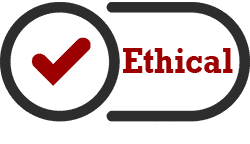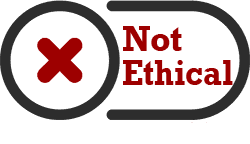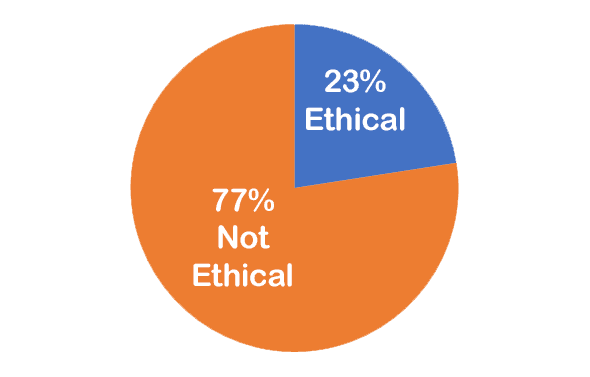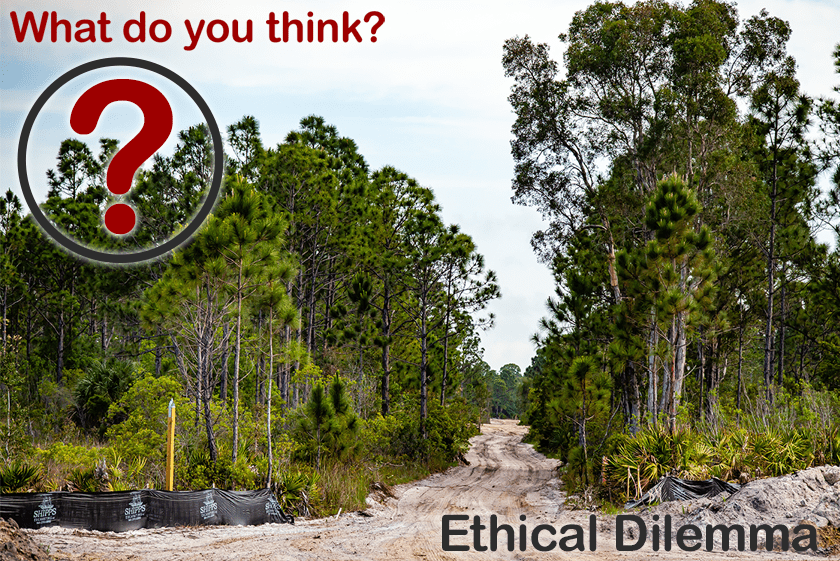This is the November 2021 edition of our monthly series of Ethics case studies titled What Do You Think? This series is comprised of case studies from NSPE archives, involving both real and hypothetical matters submitted by engineers, public officials and members of the public.
Your peers and the NSPE Board of Ethical Review have reviewed the facts of the case as shown below. And, here are the results.
Your opinion has been registered for the November 2021 edition of our monthly series of Ethics case studies titled What Do You Think?
Your vote is recorded as:

Want to know how your peers voted? We’ll send you an email with the poll results on November 23.
Your opinion has been registered for the November 2021 edition of our monthly series of Ethics case studies titled What Do You Think?
Your vote is recorded as:

Want to know how your peers voted? We’ll send you an email with the poll results on November 23.
A Review of the Facts
Engineers Tom and Larry are in a joint venture in an engineering and construction management practice that provides civil and municipal engineering and construction management services for clients in a number of towns in the state. The joint venture is hired by a developer to design a 90-lot subdivision in the town of Centerville. Tom provides the engineering design and Larry provides construction management services for the project.
During a review by officials in Centerville, it is determined by the officials that a second road will be needed to access the subdivision. However, the second road exits into the town of Nearville, which is adjacent to Centerville. Tom and Larry’s joint venture owns undeveloped property in Nearville, and their joint venture also serves as municipal engineer in Nearville.
It is clear that the property owned by Tom and Larry will be positively affected by the construction of the new road. As the municipal engineer for Nearville, the joint venture of Tom and Larry discloses its relationship with the Developer to Nearville with regard to Centerville but does not disclose its ownership of the property in Nearville. On this basis, Nearville does not object to Tom and Larry making a recommendation regarding the feasibility of the construction of the proposed road. Thereafter, as the municipal engineer for Nearville, Tom and Larry’s joint venture recommends that Nearville approve construction of the proposed road.
1. Would it be ethical for Tom and Larry to serve as the engineers for the Developer and also serve as the municipal engineer for Nearville under the circumstance described?
2. Was it ethical for Tom and Larry to recommend approval of the road under the circumstances described?
Here is the result of our survey of your peers:

Applicable NSPE Code References:
Code II.4.a: Engineers shall disclose all known or potential conflicts of interest that could influence or appear to influence their judgment or the quality of their services.Code II.4.d: Engineers in public service as members, advisors, or employees of a governmental or quasi-governmental body or department shall not participate in decisions with respect to services solicited or provided by them or their organizations in private or public engineering practice.
Discussion
Professional engineers are often faced with conflicts of interest in their professional practice. Conflicts of interest present some of the thorniest ethical issues for engineers because the practice of engineering, by its very nature, involves relations with parties often with conflicting interests. Earlier versions of the NSPE Code of Ethics prohibited engineers from engaging in any activities that presented a conflict of interest. However, this approach was criticized as unworkable, and the Code was ultimately revised to reflect the basic notion that an engineer has an obligation to disclose all known or potential conflicts of interest to employers or clients by promptly informing them of any business association of interest, or other circumstance which could influence, or appear to influence, the engineer’s judgment or the quality of services. On this basis, engineers were deemed to have met their ethical responsibility in situations involving conflicts-of-interest by providing full and timely disclosure to their employers or clients.
Some have criticized this more modern approach because it could be interpreted as shielding serious conflicts of interest which could impact a client’s interests or even the public safety where the client or employer either (1) is unsophisticated and has little understanding of the impact of the conflict or (2) colludes in the conflict. Under such circumstances, the Engineer could arguably defend such action by arguing that “I did what the NSPE Code of Ethics requires and informed the employer/client of the conflict of interest and the employer/client did not object and therefore I proceeded.” Another related criticism of this approach is that it takes away responsibility for making the ethical determination from the engineer and places it with the client or the employer. Some have noted that this shift has the effect of reducing the scope of the engineer’s professional judgment and autonomy.
A good example of the Board’s struggle with this issue was Case No. 85-6. In that case, Engineer A was retained by the state to perform certain feasibility studies relating to a possible highway spur. The state was considering the possibility of constructing the highway spur through an area that was adjacent to a residential community in which Engineer A’s property was located. After learning of the proposed location for the spur, Engineer A disclosed to the state the fact that his residential property might be affected by the new spur and fully disclosed the potential conflict with the state. The state did not object to Engineer A performing the work and Engineer A proceeded with his feasibility study and ultimately recommended that the spur be constructed.
In reviewing the question of whether it was ethical for Engineer A to perform the feasibility study despite the fact that Engineer A’s land might be affected thereby, the Board determined that the ethical obligations contained in Code II.4.a. do not require the engineer to “avoid” any and all situations that may or may not raise the specter of a conflict of interest. Such an interpretation of the NSPE Code would leave engineers with neither any real understanding of the ethical issues nor any guidance as to how to deal with the problem (of conflicts of interest). The Board noted that the purpose of a code of ethics is to provide the engineering profession with a better understanding and awareness of ethical issues that impact the public. Only through interacting with the public and clients will engineers be able to comprehend the true dimensions of ethical issues.
Turning to the facts of Case No. 97-4, the Board believes that Tom and Larry did not meet the requirements of Code II.4.a. because the engineers provided only limited disclosure of their conflict or potential conflicts of interest. By disclosing their relationship with the Developer with regard to Centerville, but failing to disclose their ownership of undeveloped property in Nearville, the engineers did not provide Nearville with a full range of all known or potential conflicts of interest or other circumstances that could influence or appear to influence their judgment or the quality of their services.
It is not clear to the Board what the reasons were for the engineers’ not providing full and complete disclosure, but it appears that had the engineers provided full disclosure, it is at least a possibility that Nearville’s decision not to object to the engineers’ making a feasibility recommendation regarding the new road may have been different. In the interests of full and timely disclosure, Tom and Larry owed this information to Nearville, and their failure to provide it was a violation of the NSPE Code of Ethics.
With regard to a possible violation of Code II.4.d., it must be assumed from the facts that the engineers’ recommendation to Nearville regarding the new road was based upon a review of documents and information involving professional services solicited or provided by them in their public or private engineering practice—the services they had provided for the Developer in connection with the subdivision project in Centerville. There is nothing in the facts or circumstances of this case to indicate that Tom and Larry had solicited or reviewed any other plans, drawings, documents, reports, recommendations, or alternatives that were prepared by unrelated or disinterested parties. On that basis, there appears to be a clear violation of NSPE Code II.4.d., which prohibits engineers in public service as advisors or employees of a governmental body to participate in decisions involving such information.
The Ethical Review Board’s Conclusion

1. It was not ethical for Tom and Larry to serve as the engineers for the Developer and also serve as the municipal engineer for Nearville because there was only partial disclosure, and no disclosure of the engineers’ ownership of undeveloped property in Nearville.
2. It was not ethical for Tom and Larry to recommend approval of the road because, as employees or advisors in public service to Nearville, the engineers could not participate in decisions involving professional services provided by them in their private practice.
BOARD OF ETHICAL REVIEW
James G. Fuller, P.E.; William E. Norris, P.E.; Paul E. Pritzker, P.E.; Richard Simberg, P.E.; Jimmy H. Smith, P.E., Ph.D.; C. Allen Wortley, P.E.; Donald L. Hiatte, P.E., Chairman
Note – In regard to the question of application of the Code to corporations vis-a-vis real persons, business form or type should not negate nor influence conformance of individuals to the Code. The Code deals with professional services, which services must be performed by real persons. Real persons in turn establish and implement policies within business structures. The Code is clearly written to apply to the Engineer and it is incumbent on a member of NSPE to endeavor to live up to its provisions. This applies to all pertinent sections of the Code. This opinion is based on data submitted to the Board of Ethical Review and does not necessarily represent all of the pertinent facts when applied to a specific case. This opinion is for educational purposes only and should not be construed as expressing any opinion on the ethics of specific individuals. This opinion may be reprinted without further permission, provided that this statement is included before or after the text of the case.








I believe this should have been two separate votes since there were two separate questions.
The property ownership should be disclosed.
This case seemed pretty clear cut to me. I did appreciate the discussion about the levels of disclosure in the past and the fact that the current NSPE really transfers the decision to the public officials who decide if an engineer’s connections to a project are ethical or not.
I agree that there were two separate ethical issues here. Disclosure of the ownership of the parcel in Nearville to both clients is in my opinion obligatory, and would shift responsibility onto the appropriate parties (municipal officials) to make the decision as to whether they saw a conflict of interest. In this case, I don’t see an actual conflict of interest because the second road entry to Nearville appears to benefit all parties.
The key word is “all” in “all known or potential conflicts of interest”. They did not include the portion that had the most potential to benefit themselves. In some ways this is worse because they gave the appearance of revealing potential conflicts while not revealing the most significant one. Any worthwhile investigation should include visiting public records for property ownerships of these engineers which would have revealed this conflict. I see this as being something that could be taken as simply being dishonest, which I regard as putting your license in jeopardy.
In reality, it is probably better for the politco’s to decide since they are the ones who will take the heat. In this case, it is not real clear HOW much Tom & Larry will benefit. Too frequently, roads are sold to the various entities on the grounds that, “it will increase economic activity” or “Thru the magic of increased appraisal values there will be funds to…”. There is a difference between a road that runs next to a development access (values increase because gas stations and convenience stores will build NEXT to the road), and a road that runs by a property that will not qualify for immediate commercial sale.
The ownership of the property should have been disclosed.